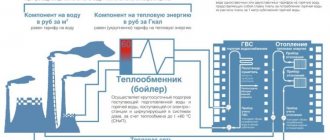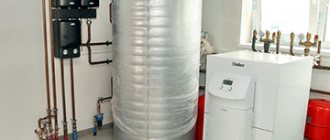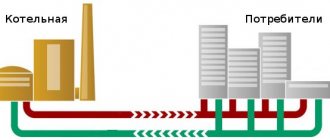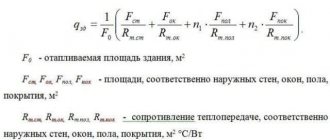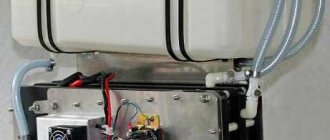Thermal energy is a system for measuring heat that was invented and used two centuries ago. The basic rule for working with this value was that thermal energy is conserved and cannot simply disappear, but can be transformed into another type of energy.
There are several generally accepted units for measuring thermal energy . They are mainly used in industrial sectors such as energy. The most common ones are described below:
- Calorie is a unit of measurement that is not included in the general system, but is often used for comparison with other parameters. Basically, calculations are made in kilocal, Megacal, Gigacal;
- A ton of steam is one of the specific and most rarely used quantities used to measure the amount of heat energy in particularly large volumes. One unit of "ton of steam" equals the amount of steam that can be produced from 1 ton of water;
- The joule is a common SI unit of measurement used to generally denote the amount of energy in its various forms. The main quantities are kJ, MJ, GJ;
- kW per hour (kW x h) is the basic unit of measurement of electrical energy, used in particular by the CIS countries.
Any unit of measurement included in the SI system has a purpose in determining the total amount of one or another type of energy, such as heat or electricity. The measurement time and quantity do not affect these values, which is why they can be used for both consumed and already consumed energy. In addition, any transmission and reception, as well as losses, are also calculated in such quantities.
What is Gcal
The cost of heating is important for residents of high-rise buildings with a central coolant supply.
The concept gigacalorie means a unit of measurement of thermal energy in heating. This energy within the room is transferred by convection from batteries to objects and radiated into the air. A calorie is the amount of energy required to warm 1 g of water by 1 degree at atmospheric pressure.
To calculate thermal energy, another unit is used - Gcal, equal to 1 billion calories. On average, heat consumption per 1 sq. m in Gcal in the Russian Federation is 0.9342 Gcal/month. If we convert the indicator into other values, 1 Gcal will be equal to:
- 1162.2 kW/h;
- heating 1 thousand tons of water to +1 degree.
The value was approved in 1995.
Features of Gcal for residential high-rise buildings
The thermostat allows you to control the flow of coolant and temperature.
If a multi-apartment building is not equipped with a common building or individual meter, thermal energy is calculated based on the area of the premises. When there is a metering device, horizontal or sequential route routing, residents independently determine the amount of thermal energy. For this we use:
- Throttling of radiators. When traffic is limited, the temperature decreases and energy consumption decreases.
- A general thermostat is installed on the return line. Coolant consumption depends on the temperature in the apartment. At low flow rates the temperature is higher, at high flow rates it is lower.
An apartment in a new building is mainly equipped with an individual meter.
Specifics of Gcal for a private home
The cheapest fuel in terms of gigacalories are pellets.
The material spent on heating is determined by the tariff for private buildings. According to average data, the cost of 1 Gcal is equal to:
- gas – natural 3.3 thousand rubles, liquefied 520 rubles;
- solid fuel - coal 550 rubles, pellets 1.8 thousand rubles;
- diesel – 3270 rub.;
- electricity – 4.3 thousand rubles.
The price of thermal energy depends on the region in which a private house is located.
Heat capacity
The heat capacity c of a given substance means the number of calories required to heat 1 kg of a substance by 1 ° C. To heat g kg of a substance having a heat capacity c by t degrees, g is required. With. t calories
Heat capacity of various substances at 15°C
| Alcohol | 0,58 | Aluminum | 0,214 | Benzene | 0,41 |
| Bronze | 0,09 | Water | 0,999 | water vapor | 0,48 |
| Gypsum | 0,20 | Granite | 0,20 | Graphite | 0,2 |
| Charcoal | 0,2 | Iron | 0,111 | Gold | 0,031 |
| Kerosene | 0,51 | Brass | 0,090 | Ice | 0,463 |
| Coal | 0,31 | Machine oil | 0,40 | Copper | 0,092 |
| Marble | 0,20 | Nikkel | 0,105 | Tin | 0,054 |
| Platinum | 0,032 | Mercury | 0,0333 | Lead | 0,031 |
| Sulfur | 0,17 | Sulfuric acid | 0,33 | Silver | 0,055 |
| Turpentine | 0,42 | Steel | 0,114 | Glass | 0,19 |
| Antimony | 0,050 | Zinc | 0,002 | Ether | 0,56 |
Heat capacity is not constant: with increasing temperature it increases slightly for all bodies except mercury, for which it decreases
General principles of calculations
How thermal energy is calculated is established by PP No. 354. The calculations are carried out by utility companies, but residents themselves are allowed to make them. Heat consumption can be determined after calculating the amount of thermal energy spent on heating per year. This period allows us to obtain an average standard, since costs are lower in summer and more in winter. Payment according to the standard provides for equal costs for the heating period or calendar year.
The calculation scheme depends on several factors:
- equipping the house with a thermal energy meter;
- the ability to account for heating of all rooms using individual devices;
- The calendar time for making payment is winter or all year.
It is more difficult to calculate thermal energy for an apartment building than for a private one. This is due to the presence of common places, residential and non-residential premises, and ownership rights. Taking into account the dependence of heat energy on the dimensions of the room, it is worthwhile to refer to PP No. 354 and PP No. 306. They indicate the distribution of the volume of heat used by the house in proportion to the area of the apartments. The readings of the general meter are divided by the proportion of housing owners.
Physical meaning of the heating consumption standard
Apartment buildings in the legislation of the Russian Federation, including for the purpose of calculating the volume of heat energy consumption for heating, are considered as indivisible units. That is, an apartment building is a single thermal engineering facility that consumes heat energy to heat the premises included in it. And it is the total volume of heat energy consumed by the entire house that is important when calculating the utility service provider (ICU) with the resource supply organization (RSO).
The rules for establishing and determining standards for the consumption of utility services, approved by the RF PP dated May 23, 2006 N306 (hereinafter referred to as Rules 306), in order to calculate the standard consumption of utility services for heating, first provide for the calculation of the amount of thermal energy required for heating an apartment building or residential building during the year (clause 19 of Appendix 1 to Rule 306, formula 19). The year was chosen as the period for which the calculation is made in order to further obtain the average value of the standard heat energy consumption per month, since in different calendar months the heat energy consumption for heating will, of course, be different, and payment according to the standard implies the same amount of payment for heating either within heating period, or evenly throughout the calendar year, depending on the method of payment for heating .
Since an apartment building consists of a set of residential and non-residential premises and common areas (common property), while the common property on the right of common ownership belongs to the owners of individual premises of the house, the entire volume of thermal energy entering the house is consumed by the owners of the premises of such a house. Consequently, payment for heat energy consumed for heating must be made by the owners of the apartment building premises. And here the question arises - how to distribute the cost of the entire volume of heat energy consumed by an apartment building among the owners of the premises of this apartment building?
Guided by the completely logical conclusions that the consumption of heat energy in each specific room depends on the size of such a room, the Government of the Russian Federation has established a procedure for distributing the volume of heat energy consumed by the entire house among the premises of such a house in proportion to the area of these premises. This procedure is provided for both by Rule 354 (distribution of readings from a common house heating meter in proportion to the shares of the premises of specific owners in the total area of all premises of the house owned) and Rule 306 when establishing heating consumption standards.
Paragraph 18 of Appendix 1 to Rule 306 states: “18. The consumption standard for heating utilities in residential and non-residential premises (Gcal per 1 sq.m. of the total area of all residential and non-residential premises in an apartment building or residential building per month) is determined by the following formula (formula 18):
,
where: - the amount of thermal energy consumed during one heating period by apartment buildings not equipped with collective (common building) heat energy metering devices, or residential buildings not equipped with individual thermal energy metering devices (Gcal), determined by formula 19; - the total area of all residential and non-residential premises in apartment buildings or the total area of residential buildings (sq.m); - a period equal to the duration of the heating period (the number of calendar months, including incomplete ones, in the heating period).”
Methods for calculating the amount of heat
Formula for calculating gigacalories by room area
You can determine the cost of a gigacalorie of heat depending on the availability of a metering device. Several schemes are used in the Russian Federation.
Payment without meters during the heating season
The calculation is based on the area of the apartment (living rooms + utility rooms) and is made according to the formula:
P=SхNхT, where:
- P – amount to be paid;
- S – size of the area of the apartment or house in m²;
- N – heat expended for heating 1 square in 1 month in Gcal/m²;
- T – tariff cost of 1 Gcal.
Example. The energy provider supplies heat for a one-room apartment of 36 square meters at 1.7 thousand rubles/Gcal. The consumer norm is 0.025 Gcal/m². For 1 month, heating services will be: 36x0.025x1700=1530 rubles.
Payment without meter for the whole year
Without a meter, the calculation formula P=Sx(NxK)xT also changes, where:
- N – rate of thermal energy consumption per 1 m2;
- T – cost of 1 Gcal;
- K – payment frequency coefficient (the number of heating months is divided by the number of calendar months). If the reason for the absence of an accounting device is not documented, K increases by 1.5 times.
Example. A one-room apartment has an area of 36 m2, a tariff of 1,700 rubles per Gcal and a consumer norm of 0.025 Gcal/m2. Initially, you need to calculate the periodicity coefficient for 7 months of heat supply. K=7:12=0.583. Next, the numbers are substituted into the formula 36x(0.025x0.583)x1700=892 rubles.
Cost if there is a common house meter in winter
The cost of a gigacalorie depends on the type of fuel used for a high-rise building.
This method allows you to calculate the price for central heating with a common building meter. Since thermal energy is supplied for the entire building, the calculation is based on area. The formula P=VxS/StotalxT is used, where:
- P – monthly cost of services;
- S – area of a separate living space;
- Stotal – the size of the area of all heated apartments;
- V – general readings of the collective meter for the month;
- T – tariff cost of 1 Gcal.
Example. The square footage of the owner’s housing is 36 m2, the entire high-rise building is 5000 m2. Monthly heat consumption is 130 Gcal, the cost of 1 Gcal in the region is 1,700 rubles. Payment for one month is equal to 130 x 36 / 5000 x 1700 = 1591 rubles.
Metering devices are available in all apartments
The cost of heating services using an individual meter is 30% lower.
Depending on the presence of a collective meter at the entrance and a personal appliance in each apartment, there is a change in readings, but this does not apply to tariffs for heating services. Payment is divided between all owners according to area parameters as follows:
- Calculate the difference in heat consumption on the common house and personal meters using the formula Vdiff.=V- ∑Vroom.
- The resulting figure is substituted into the formula P=(Vroom+VрxS/Stotal)xT.
The meanings of the letters are deciphered as follows:
- P – amount to be paid;
- S – indicator of the area of a separate apartment;
- Stotal – the total area of all apartments;
- V – collective heat consumption;
- Vpom – individual heat consumption;
- Vр – difference in readings of individual and household appliances;
- T – tariff cost of 1 Gcal.
Example. In a one-room apartment of 36 m2, an individual meter was installed, which showed 0.6. On the brownie it reads 130, a separate group of devices gave 118. The square footage of a high-rise building is 5000 m2. Monthly heat costs are 130 Gcal, payment for 1 Gcal in the region is 1,700 rubles. First, the difference in readings Vр = 130 - 118 = 12 Gcal is calculated, and then a separate payment P = (0.6 + 12 x 36 / 5000) x 1700 = 1166.88 rubles.
Applying a multiplying factor
Based on PP No. 603, heating fees are charged 1.5 times more if the meter is not repaired within 2 months, or if it is stolen or damaged. An increasing factor is also established if homeowners do not transmit the readings of the device or twice do not allow specialists to check its technical condition. You can independently calculate the increasing coefficient using the formula P=Sx1.5 NxT.
Formula for calculating thermal energy (per 1 square meter)
The exact formula for calculating thermal energy for heating is taken in the ratio of 100 W per 1 square. During the calculations, it takes the form:
Q = (S × 100) × a × b× c × d × e × f × g × h × i × j × k × l × m.
Latin letters indicate correction factors:
- a is the number of walls in the room. For an internal room it is 0.8, for one external structure - 1, for two - 1.2, for three - 1.4.
- b – location of external walls along the cardinal directions. If the room faces north or east - 1.1, south or west - 1.
- c – the ratio of the room to the wind rose. House on the windward side - 1.2, on the leeward side - 1, parallel to the wind - 1.1.
- d – climatic conditions of the region. Indicated in the table.
| Temperature, degrees | Coefficient |
| From -35 | 1,5 |
| -30 to -34 | 1,3 |
| -25 to -29 | 1,2 |
| -20 to -24 | 1,1 |
| -15 to -19 | 1 |
| -10 to -14 | 0,9 |
| To 10 | 0,7 |
- e – insulation of the wall surface. For structures without insulation - 1.27, with two bricks and minimal thermal insulation - 1, good insulation - 0.85.
- f – ceiling height. Indicated in the table.
| Height, m | Coefficient |
| Up to 2.7 | 1 |
| 2,8-3 | 1,05 |
| 3,1-3,5 | 1,1 |
| 3,6-4 | 1,15 |
- g – features of floor thermal insulation. For basements and plinths - 1.4, with insulation on the ground - 1.2, if there is a heated room below - 1.
- h – features of the upper room. If there is a cold hill above - 1, an attic with insulation - 0.9, a heated room - 0.8.
- i – design features of window openings. If there is double glazing - 1.27, single-chamber double-glazed windows - 1, two-chamber or three-chamber glass with argon gas - 0.85.
- j – general parameters of the glazing area. It is calculated by the formula x = ∑Sok / Sp, where ∑Sok is the indicator common to all windows, Sp is the quadrature of the room.
- k – presence and type of entrance opening. A room without a door -1, with one door to the street or loggia - 1.3, with two doors to the street or loggia - 1.7.
- l – battery connection diagram. Listed in the table
| Inset | Peculiarities | Coefficient |
| Diagonal | Supply at the top, return at the bottom | 1 |
| One-sided | Supply at the top, return at the bottom | 1,03 |
| Double sided | Return and supply below | 1,13 |
| Diagonal | Feed below, return above | 1,25 |
| One-sided | Feed below, return above | 1,28 |
| Unilateral | Supply and return below | 1,28 |
- m – specifics of radiator installation. Indicated in the table.
| Connection type | Coefficient |
| Open on the wall | 0,9 |
| On top, hidden by a shelf or window sill | 1 |
| Closed at the top with a niche | 1,07 |
| Covered with a niche/window sill at the top and an overlay at the end | 1,12 |
| With decorative body | 1,2 |
Before using the formula, make a diagram with data for all coefficients.
Latent heat of fusion
The latent heat of fusion of a substance is the number of large calories expended to transform 1 kg of a substance from a solid to a liquid without increasing the temperature. The same amount of heat is released when the molten substance solidifies
Latent heats of fusion of various substances
| Aluminum | 94 | Ammonia | 33,4 | Bismuth | 10,2 |
| Blast furnace slag | 50 | Cadmium | 10,8 | Ice (water) | 79,7 |
| Copper | 41 | Naphthalene | 36 | Tin | 13,8 |
| Platinum | 27 | Mercury | 2,8 | Lead | 5,5 |
| Sulfur | 9 | Silver | 26,0 | Phosphorus | 5,0 |
| Zinc | 23,0 | Benzene | 30,4 | Iron | 49 |
Metering devices for houses and apartments
A special device allows you to accurately calculate tariffs for water supply, electricity, gas and heat. Users are allowed to install a heat meter to record heat energy consumption. The device measures in Gcal/h, kW/h and kJ/h. Popular today.
Vane meters
The vane meter operates effectively at temperatures below 22 degrees.
The meter has the form of a mechanism with a perpendicular axis of rotation. The model is characterized by low sensitivity, which allows you to accurately measure heat costs. The regulators are suitable for rooms with good thermal insulation and temperatures of +26 degrees. The vane device, when adjusting the temperature up to +22 degrees, counts a minimum of Gcal.
Advantages:
- inexpensive cost;
- power supply from batteries;
- ease of use;
- accuracy of measurements.
Minuses:
- risk of breakdowns due to water hammer;
- rapid wear of the mechanism;
- increased pressure in the system;
- When the impeller jams, the water flow is not allowed to pass through.
Vane-type devices are suitable for taking readings when a small volume of water is used.
Devices with jump recorders
Electronic devices are more expensive, but they count gigacalories more accurately.
The pulse device takes readings remotely from 2-16 channels, so it is suitable for a private or apartment building. Data recording and transmission is carried out on an LCD monitor, via a plug-in interface, to a laptop or computer using a network cable, or via a GSM network.
The scenario for which readings need to be measured is specified by the user. Ultrasonic devices can be connected to the water and gas supply system, are part of the ASKUE system, or can be combined with the “smart home” system.
Advantages:
- many options for public and private measurements;
- possibility of integration into several accounting systems;
- strength due to the absence of moving parts;
- beautiful appearance and compactness;
- protection from dust and moisture – the meter can be placed in the kitchen or outdoors;
- durable body;
- self-diagnosis functions for problems;
- extensive communication;
- execution with or without a removable computing unit;
- the period between inspections is 6 years, between replacements is 10 years.
Minuses:
- high price;
- communication capabilities depend on the specifics of the output;
- costs for the purchase of flow meters, pressure sensors, remote control modules for basic equipment.
For outdoor use, models with difference recorders with a moisture protection level of IP 68 are suitable.
Loads on DHW, ventilation
Heating point
Fresh air is necessary for human life, which is why ventilation systems are required. However, ventilation significantly increases heat loss.
Loss compensation significantly increases the overall thermal load. Taken into account at the design and calculation stage. Formula:
Q=qV(tn.-tv.)
V is the total volume of the building along the external contour,
t (n and v) – external, internal air temperature;
q – specific value.
Formula for calculating the hot water supply to a building:
Q=0.042rV*∆ T * P * G
∆T – water temperature difference;
P – number of consumers (sinks);
B – load ratio according to GOST;
r is the density of water.
Results of all calculations
In an insulated house, the number of gigacalories consumed will be less.
If you use the calculation formula correctly, you can find out the number of Gcal of thermal energy consumed. The information will help you plan your budget and clarify the final amount to be paid. Based on the above formulas, we can conclude that gigacalories are spent on a building of up to 200 square meters. This value is equal to 3 Gcal per month. Taking into account the duration of the heating season in most regions of the Russian Federation at 6 months, it is easy to determine the approximate heat consumption. You will need to multiply 3 Gcal by 6 months. The result is 18 Gcal.
It is easier to calculate the cost of gigacalories for a private home using the indicators of an individual meter. The settlement process for apartments is complicated by the presence of a house and personal meter. However, this procedure is carried out independently without visiting special organizations.
To calculate thermal energy, special mathematical formulas are used. They contain the most accurate data, and energy providers are informed about their own calculations. When making calculations, you can use online calculators or contact specialists who will perform all operations, focusing on the indicators of your premises and the type of meter.
Shrinkage
As metals solidify and cool, their dimensions change. The resulting tensions, caused by uneven cooling and unequal distribution of material, increase or decrease the dimensions on one side or the other of the casting
| Metal | Linear relative | Linear cm per 1m | Surface relative | Surface cm3 per 1m3 | Volume relative | Volume cm3 per 1m3 |
| Aluminum | 1:56 | 1,79 | 1:28 | 357 | 1:19 | 53590 |
| Aluminum bronze | 1:53 | 1,89 | 1:27 | 377 | 1:18 | 56610 |
| Bronze | 1:63 | 1,59 | 1:32 | 317 | 1:21 | 47610 |
| Bell met. | 1:65 | 1,54 | 1:33 | 308 | 1:22 | 46140 |
| Brass | 1:65 | 1,54 | 1:32 | 313 | 1:22 | 46140 |
| Copper | 1:125 | 0,80 | 1:63 | 160 | 1:42 | 24000 |
| Tin | 1:128 | 0,78 | 1:64 | 156 | 1:43 | 23400 |
| Steel | 1:50 | 2,00 | 1:25 | 400 | 1:17 | 60000 |
| Lead | 1:92 | 1,09 | 1:46 | 217 | 1:31 | 32610 |
| Zinc | 1:62 | 1,61 | 1:32 | 313 | 1:21 | 48300 |
| Cast iron | 1:96 | 1,04 | 1:48 | 208 | 1:32 | 31260 |
Definition [edit | edit code]
The amount of heat is included in the mathematical formulation of the first law of thermodynamics, which can be written as Q = A + ΔU. Here Δ U is the change in the internal energy of the system, Q is the amount of heat transferred to the system, and A is the work done by the system. However, the definition of heat must indicate the method of its measurement, regardless of the first principle. Since heat is the energy transferred during heat exchange, a test calorimetric body is needed to measure the amount of heat. By changing the internal energy of the test body, it will be possible to judge the amount of heat transferred from the system to the test body. Without the use of a test body, the first principle loses the meaning of a meaningful law and turns into a determination of the amount of heat that is useless for calculations.
Let in a system consisting of two bodies X and Y, body Y (test) is enclosed in a rigid adiabatic shell. Then it is not capable of performing macroscopic work, but can exchange energy (that is, heat) with body X. Let us assume that body X is also almost completely enclosed in an adiabatic, but not rigid shell, so that it can perform mechanical work, but can only exchange heat with Y. The amount of heat
, transferred to body X in a certain process, is the quantity QX = − Δ UY =-Delta U_>, where Δ UY > is the change in the internal energy of body Y. According to the law of conservation of energy, the total work done by the system is equal to the decrease in the total internal energy of the system of two bodies: A = − Δ U x − Δ U y -Delta U_>, where A is the macroscopic work done by body X, which allows us to write this relation in the form of the first law of thermodynamics: Q = A + Δ U x > .
| Types of energy: | ||
| Mechanical | Potential Kinetic | |
| ‹ ♦ › | Internal | |
| Electromagnetic | Electrical Magnetic | |
| Chemical | ||
| Nuclear | ||
| G | Gravitational | |
| ∅ | Vacuum | |
| Hypothetical: | ||
| Dark | ||
| See also: Law of Conservation of Energy | ||
Thus, the amount of heat introduced in phenomenological thermodynamics can be measured by means of a calorimetric body (the change in internal energy of which can be judged by the reading of the corresponding macroscopic device). From the first law of thermodynamics it follows that the introduced definition of the amount of heat is correct, that is, the independence of the corresponding quantity from the choice of test body Y and the method of heat exchange between bodies. With this determination of the amount of heat, the first law becomes a meaningful law that allows experimental verification, since all three quantities included in the expression for the first law can be measured independently [3].
Example No. 1
It is necessary to determine the correct number of sections for the M140-A radiator, which will be installed in a room located on the top floor.
In this case, the wall is external, there is no niche under the window sill. And the distance from it to the radiator is only 4 cm. The height of the room is 2.7 m. Qn=1410 W, and tв=18 °С. Conditions for connecting the radiator: connection to a single-pipe riser of a flow-regulated type (Dy20, KRT tap with 0.4 m inlet); The heating system is routed from the top, tg = 105°C, and the coolant flow through the riser is Gst = 300 kg/h. The temperature difference between the coolant in the supply riser and the one in question is 2°C. Determine the average temperature in the radiator:
tav = (105 - 2) - 0.5x1410x1.06x1.02x3.6 / (4.187x300) = 100.8 °C.
Based on the data obtained, we calculate the heat flux density:
tav = 100.8 - 18 = 82.8 °C
It should be noted that there was a slight change in the level of water consumption (360 to 300 kg/h). This parameter has virtually no effect on qnp.
Qpr =650(82.8/70)1+0.3=809W/m2.
Next, we determine the level of heat transfer horizontally (1g = 0.8 m) and vertically (1v = 2.7 - 0.5 = 2.2 m) located pipes. To do this, you should use the formula Qtr = qinxlv + qrxlg.
We get:
Qtr = 93x2.2 + 115x0.8 = 296 W.
We calculate the area of the required radiator using the formula Ap = Qnp/qnp and Qпp = Qп - µ trхQtr:
Ar = (1410-0.9x296)/809 = 1.41 m2.
We calculate the required number of sections of the M140-A radiator, taking into account that the area of one section is 0.254 m2:
m2 (µ4 = 1.05, µ 3 = 0.97 + 0.06 / 1.41 = 1.01, we use the formula µ 3 = 0.97 + 0.06 / Ar and determine:
N=(1.41/0.254)x(1.05/1.01)=5.8. That is, the calculation of heat consumption for heating showed that in order to achieve the most comfortable temperature in the room, a radiator consisting of 6 sections should be installed.

